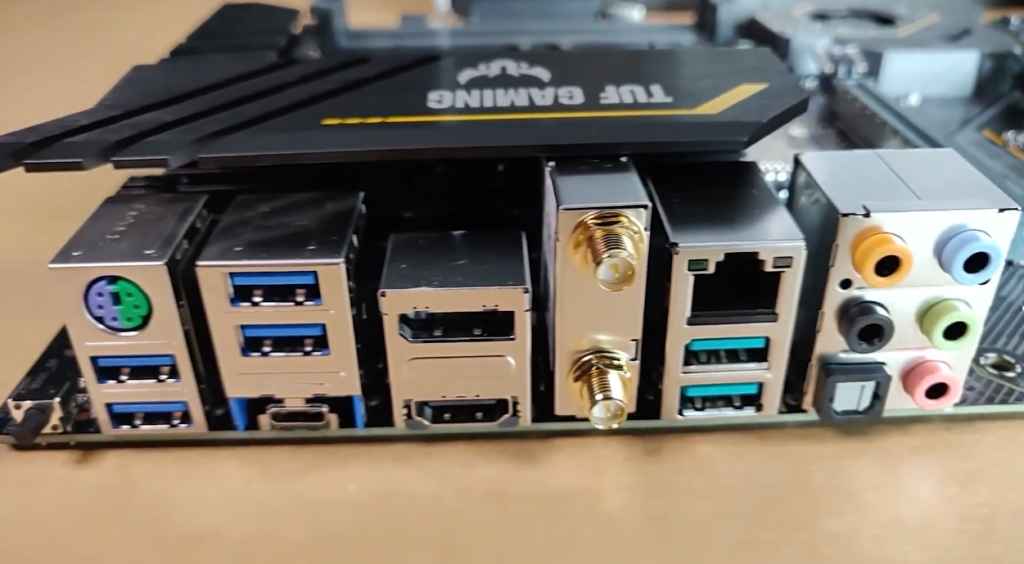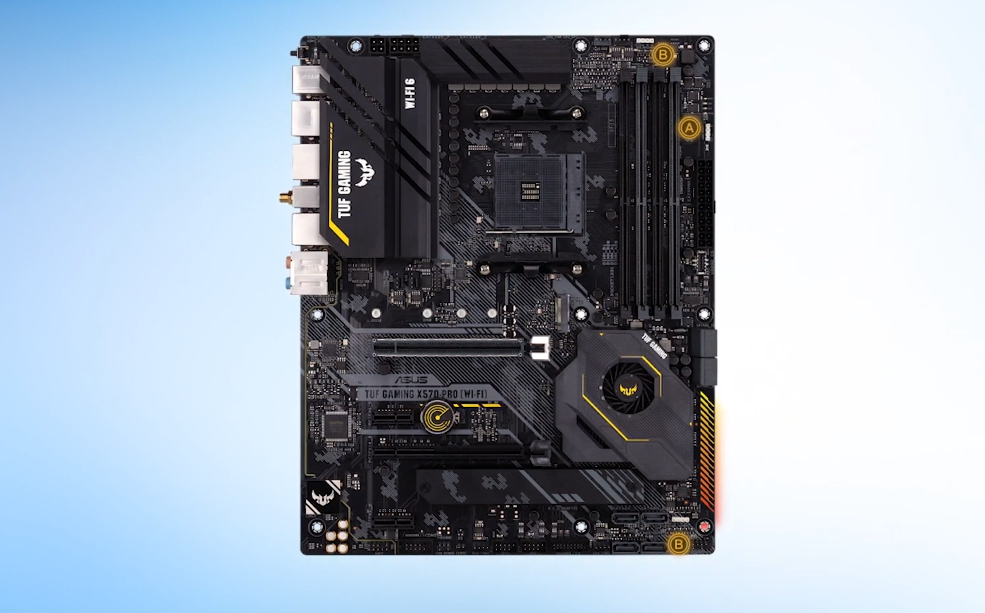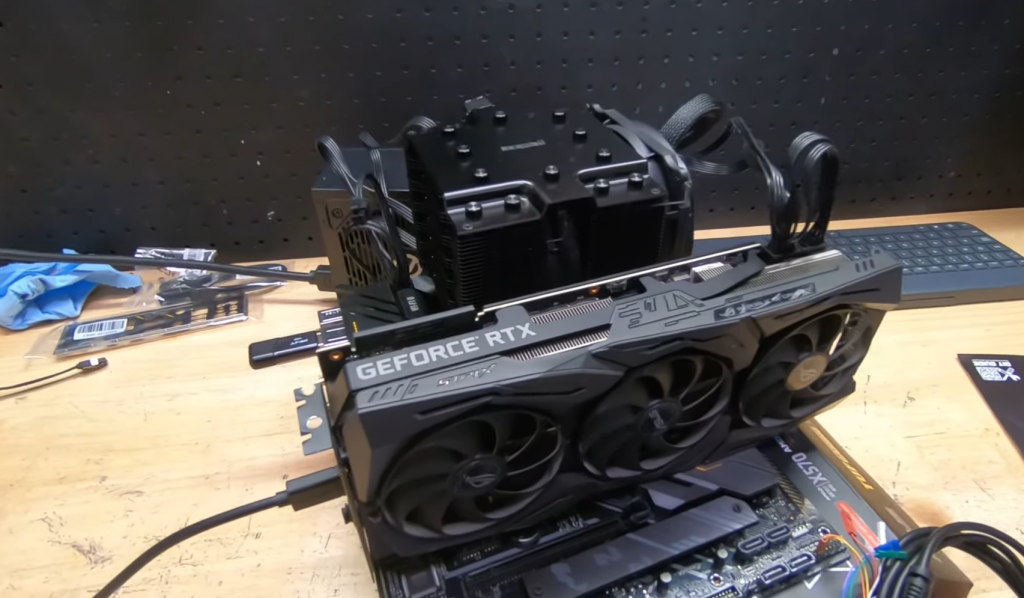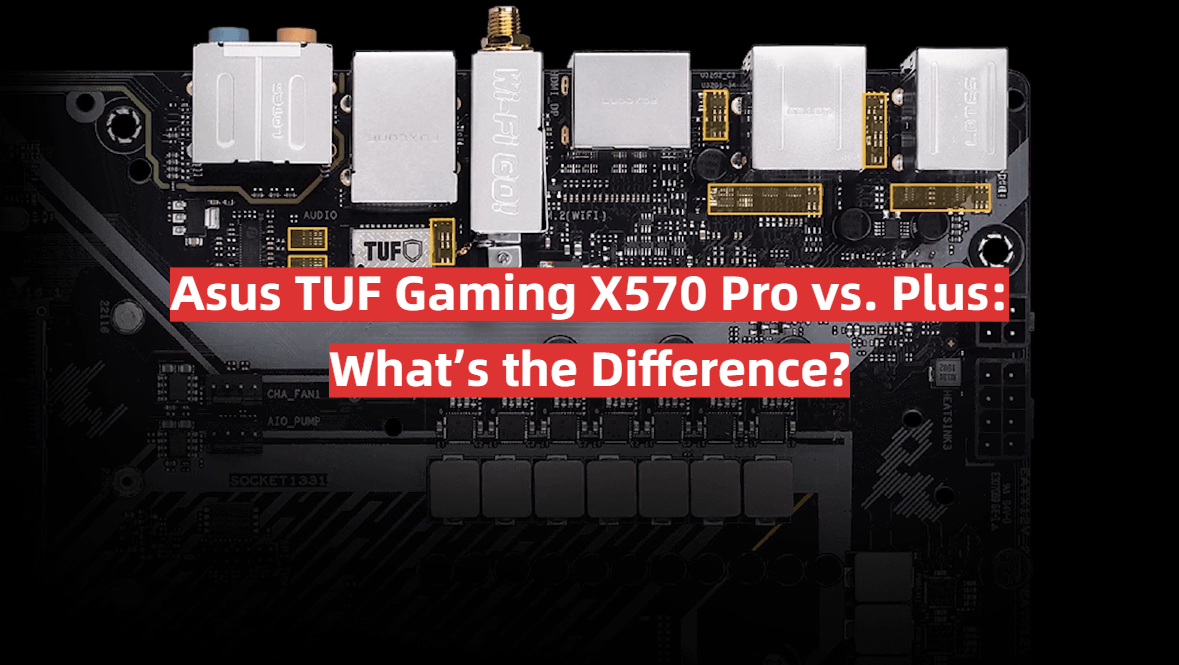Trying to determine the distinction between the Asus TUF Gaming X570 Pro and Plus models? If you’re searching for a gaming motherboard, then consider this your go-to guide. Both boards offer great features for gamers, but there are some key differences to take note of. In this article, we’ll break down the key specs of each board and help you decide which one is right for your gaming rig.
Table of Contents
What Is Asus TUF Gaming X570 Pro?
The AMD AM4 socket supports the latest 3rd Gen AMD Ryzen processors, providing you with a remarkable 64GB of DDR4 RAM that runs at an impressive 4800MHz frequency. This board has plenty of connectivity options as well, including three USB 3.2 Gen 2 Type A ports, two USB 3.2 Gen 1 Type A ports, four SATA 6 Gb/s connectors, dual M.2 slots with support for both NVMe SSDs and Intel Optane memory accelerators, and 8+4 pin ATX 12V power connectors for extra stability while overclocking. Beyond that, it also includes ASUS’ acclaimed Aura Sync RGB lighting, which allows you to customize the look and feel of your system with a wide range of vibrant colors. [1]

What Is Asus TUF Gaming X570 Plus?
Designed to meet the needs of gamers, the Asus TUF Gaming X570 Plus motherboard offers just enough features and capabilities at a mid-range price point. Boasting compatibility with AMD’s Ryzen 3000 processor family, this motherboard provides two M.2 slots and four SATA ports to satisfy any storage expansion needs. The board also sports robust cooling options, an integrated rear I/O shield, and 8-channel HD audio. The ASUS TUF Gaming X570 Plus stands out from the crowd with its comprehensive features, including a USB Type-C port on the rear panel and Wi-Fi 6 (802.11ax) support that provide exceptional connectivity for gaming enthusiasts.
Asus TUF Gaming X570 Pro vs. Plus
Memory
The main difference between the two models is the memory support. The ASUS TUF Gaming X570 Plus supports up to 64GB of RAM, while the Pro version can handle up to 256GB.
Storage
Both boards feature four SATA ports for storage expansion and two M.2 slots for faster data access speeds. However, the Pro model offers an additional U.2 port as well as a heatsink to protect against thermal throttling during heavy loads.
Connectivity
Both motherboards offer Wi-Fi 6 (802.11ax) and USB Type-C ports on their rear panels, but only the Pro model supports Bluetooth 5 and has an integrated 10 Gbps Ethernet controller.
Ports
Outfitted with four USB 3.2 Gen 1 ports, two USB 2.0 ports and an HDMI port for video output, the ASUS TUF Gaming X570 Plus is sure to meet all of your gaming needs! The Pro model also has a DisplayPort at the rear panel and offers double the number of USB ports so you can expand your connectivity options with more peripherals. [2]
Audio
The ASUS TUF Gaming X570 Plus and Pro models both feature 8-channel HD audio. However, the Pro version has an additional optical S/PDIF out port for a richer sound experience.
Price
Of course, the biggest difference between these two motherboards is their price tag. The ASUS TUF Gaming X570 Plus retails for around $200, while the Pro model will set you back about $300.
Graphics
The Pro model also supports multi-GPU setups, so you can reap the benefits of AMD’s Crossfire technology and link up a pair of graphics cards for enhanced visuals performance.
BIOS
Both boards have a UEFI BIOS that support easy overclocking and customization. However, the TUF Gaming X570 Pro has an improved version with enhanced features and additional options for fine-tuning your system.
Network
The ASUS TUF Gaming X570 Plus also comes with an integrated Intel I211-AT network controller, while the Pro variant has both an Intel and a Realtek 2.5Gbps Ethernet controllers for faster and more reliable networking speeds.

Overall, Asus’s TUF Gaming X570 Plus and Pro models are two of the most feature-rich motherboards available in their respective classes. Meanwhile, if you’re looking for something more premium, the Pro version provides better memory support (up to 256GB), USB Type-C and more ports, as well as multi-GPU support for enhanced visuals. On the other hand, the Plus model offers decent features at a lower price point – perfect for gamers who don’t need top-of-the-line specs. Ultimately, it all comes down to your budget and what kind of features you need in order to enjoy an optimal gaming experience. [3]
Pros and Cons of Asus TUF Gaming X570 Pro
Boasting some revolutionary features, the Asus TUF Gaming X570 Pro is an absolute game-changer. It has two M.2 slots, allowing for a faster and more efficient connection to graphics cards and other peripherals. The board also supports up to 128GB of DDR4 RAM, making it ideal for gamers who need plenty of memory. Additionally, the integrated 8+2 phase power delivery helps keep your system running cool under heavy loads, while the Digi+ VRM ensures stable voltage regulation throughout all operations.
On the downside, this motherboard is not cheap. It comes with a hefty price tag that can be hard to justify for budget-conscious buyers. Additionally, some users have reported issues with their Wi-Fi connection when using this model. Moreover, the BIOS could use some refinement as it’s a bit lacking in features compared to its competitors.
Overall, the Asus TUF Gaming X570 Pro is an excellent choice for gamers who need a powerful board that can handle all their needs. It offers several advanced features and delivers great performance, but it may not be worth the high cost for users who are on a tighter budget.
Pros and Cons of Asus TUF Gaming X570 Plus
Pros:
- Wide range of features for a mid-range price point.
- Offers all the latest connectivity options, including Wi-Fi 6 support and USB 3.2 Gen 2 ports.
- AMD StoreMI technology enables faster loading times when installed with an NVMe SSD.
- Exceptional durability and design thanks to TUF components and military grade construction standards.
Cons:
- Does not come with integrated graphics, requiring a dedicated GPU for gaming or video production needs.
- Limited overclocking capabilities due to its limited power delivery system compared to other X570 boards.
- Lack of integrated rear I/O shield which adds extra cost and installation time if needed.
- A limited number of USB ports compared to other X570 boards.
Overall, the Asus TUF Gaming X570 Plus is a great option for those who are looking for a mid-range solution with plenty of features and excellent durability at an attractive price point. While it may not be suitable for hardcore overclocking needs, it still offers enough power delivery to achieve good results when paired up with a quality processor. [4]

What is Asus TUF Gaming X570 Pro Best For?
The Asus TUF Gaming X570 Pro is the best option for those who need a board with premium features and top-shelf performance. It comes with an enhanced power delivery system, advanced overclocking capabilities, integrated rear I/O shield, and support for the latest connectivity options like Wi-Fi 6. As such, this board is ideal for gamers and content creators alike who need to maximize their system’s performance and require reliable hardware for heavy workloads. Additionally, its durable construction ensures that it will last through even the toughest of conditions.
All in all, the Asus TUF Gaming X570 Pro is an excellent choice if you need a powerful motherboard with plenty of features.
What is Asus TUF Gaming X570 Plus Best For?
The Asus TUF Gaming X570 Plus is ideal for users who want a mid-range board with all of the latest features and connectivity options. It offers great durability thanks to its military grade components and wide range of ports, including USB 3.2 Gen 2 support. Additionally, it comes with AMD StoreMI technology which enables faster loading times when used in tandem with an NVMe SSD.
Overall, the Asus TUF Gaming X570 Plus is a great choice for those who are looking for a reliable motherboard at an affordable price point that can handle everyday tasks without breaking the bank. It may not have some of the higher-end features found on other boards in this category, but it still provides enough power delivery and overclocking capabilities to satisfy the needs of most users. [5]
How to Use a Motherboard?
Once you have your motherboard, the next step is to learn how to use it.
The first step in using a motherboard is installing it into your computer case. This process typically involves mounting the board onto standoffs inside the case and connecting various cables such as power, data, and audio. After everything has been connected properly, your system should be ready to boot up when you turn it on.
Once booted up, you will need to configure the BIOS settings for best performance from your system components and hardware. This includes setting up memory modules, configuring CPU overclocking settings (if applicable), and setting up drives for storage. It is important to take your time when setting up the BIOS as any misconfiguration can cause issues.
Finally, it is important to keep your motherboard drivers and firmware updated to ensure that all hardware components are running at their peak performance. This process typically involves downloading the latest drivers from the manufacturer’s website and flashing the BIOS with a USB flash drive or CD-ROM. Keeping your motherboard’s drivers and firmware up-to-date will help to eliminate potential compatibility issues with new components and operating systems.

By understanding how to use a motherboard properly, you will be able to get the most out of your system and enjoy reliable performance for years to come.
How to Maintain a Motherboard?
Maintaining an Asus TUF Gaming X570 Pro or Plus motherboard is important to ensure it continues to run optimally and perform without any issues. Here are some tips for maintaining your motherboard:
- Keep the motherboard clean by removing dust, dirt, and other debris from its surfaces regularly.
- Check all the connections periodically to make sure they are properly plugged in and that there are no loose wires or connectors.
- Make sure the ventilation system of your case is functioning properly and keeps the components cool during operation.
- Ensure you have updated drivers installed for all devices connected to the motherboard including RAM, graphics card, storage device, etc.
- Make sure you have the latest BIOS version installed.
- Test your motherboard periodically to ensure optimum performance and identify any potential problems before they become serious.
- If a problem does arise, make sure you troubleshoot it as soon as possible using the correct procedures and replacement parts, if necessary.
Following these tips can help you keep your Asus TUF Gaming X570 Pro or Plus motherboard in optimal condition so that it continues to perform optimally for years to come.

Things to Know When Buying Motherboards
When shopping for a motherboard, there are several considerations to keep in mind. First, consider what type of processor you will be using. An AMD Ryzen CPU requires an AMD chipset, while Intel CPUs require an Intel chipset.
Next, think about how much RAM you need as well as how many PCIe slots your motherboard must have in order to accommodate all of your components. If you’re anything but a low-end gamer or casual user, then it’s worth considering investing in a motherboard with more RAM and PCIe slot options.
The Asus TUF Gaming X570 Pro offers support for up to 128GB of DDR4 RAM, while the Asus TUF Gaming X570 Plus can accommodate 256GB of DDR4 RAM. Additionally, the X570 Pro has two M.2 slots and six SATA ports, while the X570 Plus has four M.2 slots and eight SATA ports – perfect for those who want extra storage capacity or faster speeds when transferring data.
Finally, consider what type of connectivity options you need from your new motherboard; both ASUS models feature built-in Wi-Fi 6 support as well as Realtek S1200A audio codecs for excellent sound quality. They also come with USB 3.2 Gen 2 ports, so you can enjoy faster data transfers and charging times.

Ultimately, it comes down to what type of processor you’re using, how much RAM and storage space you need, as well as your desired features and connectivity options when deciding which motherboard is right for you. The Asus TUF Gaming X570 Pro vs. Plus comparison should help make the decision a little easier! [6]
FAQ
What is the difference between TUF Gaming X570-Plus and TUF Gaming X570-Pro?
The main difference between the Asus TUF Gaming X570-Plus and Pro is the number of PCIe 4.0 lanes available for high-speed device connection. The X570-Plus model offers a total of 16 lanes, while the X570-Pro has 28. This makes the Pro model better suited for use with graphics cards or other devices that require higher throughput. In addition, the X570-Pro also features an additional M.2 slot compared to the Plus version, allowing users to store more data on their motherboard if desired. Furthermore, the Pro model includes Realtek S1220A 8-channel audio codec support as well as onboard Intel Gigabit Ethernet LAN ports, giving it superior audio and network performance when compared to the Plus variant. Finally, the X570-Pro supports up to 128GB of DDR4 RAM and features a better power delivery system for efficient operation.
Is ASUS TUF gaming X570-Pro WiFi good?
The ASUS TUF Gaming X570-Pro WiFi is a good option for serious gamers looking for an entry level motherboard. It features AMD AM4 socket support and the latest PCIe 4.0 architecture, making it one of the most advanced motherboards on the market today. Additionally, it has two M.2 slots for high speed storage and supports up to 128GB DDR4 RAM with overclocking potential to make sure you get the best gaming performance possible from your system. It also comes equipped with Wi-Fi 6 (802.11ax) as well as Bluetooth 5 so you can stay connected while playing online games wirelessly. All in all, this board is a great choice for those who want a quality yet affordable motherboard that offers excellent performance and features.
Is ASUS TUF gaming X570-Plus compatible with Ryzen?
Yes, the ASUS TUF Gaming X570-Plus is compatible with AMD Ryzen CPUs. This motherboard features the AMD AM4 socket and supports 2nd, 3rd and 4th generation of AMD Ryzen processors. Additionally, it is compatible with 7nm Zen3 architecture CPUs and has overclocking capabilities to allow you to get the most out of your processor. On top of that, it offers robust cooling features such as fanXpert 4 Core and active chipset heatsink to ensure maximum performance stability while gaming or multitasking.
Is the ASUS TUF X570-pro good for overclocking?
Yes, the ASUS TUF X570-Pro is great for overclocking. It offers advanced tuner technology with intuitive AI Overclocking, allowing you to easily and safely customize your system to deliver maximum performance. Additionally, it comes with a premium power delivery solution that includes 16+2 DrMOS power stages and support for DDR4 up to 4400MHz. Moreover, its FanXpert 4 Core ensures optimal cooling performance while gaming or running intensive applications. With these features in place, you can be sure that your system will remain stable even when overclocked.
Is TUF better than Strix?
The ASUS TUF Gaming X570-Plus and Strix X570-E are both great motherboards for gaming and overclocking, but they each have their own unique strengths. The TUF board offers robust cooling features such as active chipset heatsink, fanXpert 4 Core, and flexible memory support up to 4400MHz. On the other hand, the Strix board has a superior power delivery solution with 16+2 DrMOS power stages and improved networking options with Intel Wi-Fi 6. Ultimately, it comes down to what you prioritize in terms of performance when deciding which one is best for you.
What is the difference between ROG and TUF?
The main difference between the Asus ROG and TUF Gaming lines is their target audience. The ROG series are higher-end gaming motherboards aimed at gamers who want an all-out performance experience. On the other hand, the TUF series are more budget-friendly and designed for gamers looking for reliable, long-term performance without breaking the bank. In terms of features, both lines offer solid state capacitors that enhance durability, ECC memory support (on selected models), and support for multiple GPUs. However, the ROG line provides additional features like ASUS AI cooling, overclocking profiles, dual M.2 slots with heatsinks to improve cooling and thermal optimization to help keep your system running cool and efficiently. The TUF series also comes with a reinforced backplate and alloy chokes to ensure stability and longevity in gaming and everyday usage.
Useful Video: ASUS TUF Gaming X570-PLUS (WiFi) Preview & Unboxing
Conclusion
The Asus TUF Gaming X570 Pro and Plus motherboards offer a variety of features for users looking to build or upgrade their gaming PC. The Pro model has all the advantages of the Plus model, plus additional features, such as Active PCH cooling and an improved power delivery system. Both boards are great options, with the Pro offering better performance for those looking for the extra edge in their gaming experience. However, if you’re not interested in overclocking your processor or don’t need the extra features that come with the Pro version, then the basic Plus model is still an excellent choice. Ultimately, it comes down to personal preference and budget when deciding between these two motherboards. Whichever one you choose, both will provide you with a great gaming experience.
Thanks for reading! We hope this article has helped you better understand the differences between the Asus TUF Gaming X570 Pro and Plus motherboards. Remember to consider your budget and needs when making your decision, and make sure you read up on all of the features before settling on one! Good luck in finding the perfect motherboard for your build!
References
- https://versus.com/en/asus-prime-x570-pro-vs-asus-tuf-gaming-x570-plus
- https://www.asus.com/product-compare?ProductID=15025,11010&LevelId=Motherboards-Components-Motherboards
- https://www.bhphotovideo.com/c/compare/ASUS_Gaming_X570-Plus_vs_ASUS_TUF_GAMING_X570-PRO_%28WI-FI%29/BHitems/1487154-REG_1594470-REG
- https://pangoly.com/en/compare/motherboard/asus-tuf-gaming-x570-plus-vs-asus-tuf-gaming-x570-pro-wi-fi
- https://devicelist.best/en/asus-tuf-gaming-x570-plus-vs-asus-tuf-gaming-x570-pro-wi-fi/
- https://www.anandtech.com/show/14161/the-amd-x570-motherboard-overview/18







Leave a Reply